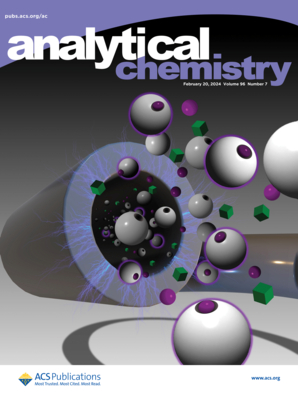Chemoproteomic Profiling of Isoprenoid Pyrophosphate Interacting Proteins with Photoaffinity Probes.
IF 6.7
1区 化学
Q1 CHEMISTRY, ANALYTICAL
引用次数: 0
Abstract
Isoprenoid pyrophosphates are key intermediates in the biosynthesis of many biologically important molecules and in the prenylation of proteins involved in various biological processes. Except for these well-studied functions, new roles of isoprenoid pyrophosphates have been reported continuously. To study their functions on the proteome scale, we developed a series of isoprenoid pyrophosphate photoaffinity probes for the covalent labeling of their interacting proteins. Through "click" reaction with the alkyne handle on the probes, fluorophores could be attached to the labeled proteins for the gel-based fluorescence analysis or cell imaging. A biotin moiety could be used instead to enrich labeled protein. Combining with SILAC-based quantitative proteomic analysis, several known and putative interacting proteins for farnesyl pyrophosphate (FPP) and geranylgeranyl pyrophosphate (GGPP) were identified, including many nucleocytoplasmic transport proteins. We have validated the interaction between transportin-1 with FPP and GGPP in vitro, suggesting potential new function of FPP and GGPP in protein transportation. This probe-labeling method could be further applied for evaluating other isoprenoid interacting proteins and exploring their cellular functions and localization, which will greatly facilitate biochemical research of isoprenoids.类异戊二烯焦磷酸盐与光亲和探针相互作用蛋白的化学蛋白质组学分析。
类异戊二烯焦磷酸盐是许多生物重要分子的生物合成和参与各种生物过程的蛋白质的前置酰化的关键中间体。除了这些已被充分研究的功能外,类异戊二烯焦磷酸盐的新作用也不断被报道。为了研究它们在蛋白质组尺度上的功能,我们开发了一系列类异戊二烯焦磷酸光亲和探针,用于它们相互作用蛋白的共价标记。通过与探针上炔柄的“点击”反应,荧光团可以附着在标记的蛋白质上,用于凝胶荧光分析或细胞成像。生物素部分可以用来丰富标记的蛋白质。结合基于silac的定量蛋白质组学分析,鉴定了几种已知和推测的法尼基焦磷酸(FPP)和香叶基焦磷酸(GGPP)相互作用蛋白,包括许多核胞质转运蛋白。我们在体外验证了转运蛋白-1与FPP和GGPP之间的相互作用,提示FPP和GGPP在蛋白质运输中可能具有新的功能。该探针标记方法可进一步应用于其他类异戊二烯相互作用蛋白的评价,探索其细胞功能和定位,将极大地促进类异戊二烯的生化研究。
本文章由计算机程序翻译,如有差异,请以英文原文为准。
求助全文
约1分钟内获得全文
求助全文
来源期刊

Analytical Chemistry
化学-分析化学
CiteScore
12.10
自引率
12.20%
发文量
1949
审稿时长
1.4 months
期刊介绍:
Analytical Chemistry, a peer-reviewed research journal, focuses on disseminating new and original knowledge across all branches of analytical chemistry. Fundamental articles may explore general principles of chemical measurement science and need not directly address existing or potential analytical methodology. They can be entirely theoretical or report experimental results. Contributions may cover various phases of analytical operations, including sampling, bioanalysis, electrochemistry, mass spectrometry, microscale and nanoscale systems, environmental analysis, separations, spectroscopy, chemical reactions and selectivity, instrumentation, imaging, surface analysis, and data processing. Papers discussing known analytical methods should present a significant, original application of the method, a notable improvement, or results on an important analyte.
 求助内容:
求助内容: 应助结果提醒方式:
应助结果提醒方式:


